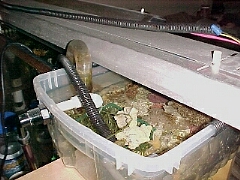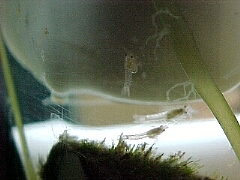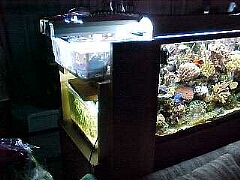Originally, this container was added to take advantage of the main tank's oversized lighting fixture. It was intended to be just a place where extra frags could be grown out for trade. However, after adding some live sand to it, it developed quite a population of small worms and crustaceans that produced swarms of zooplankton for the main tank. In fact, it out-produced the original refugium box that I have since taken down.
The overflow was added when I noticed that some scum was collecting on the surface of the water. The PVC elbow allows me to adjust the amount of water going through the overflow, simply by twisting it so that the opening is angled higher or lower.
Most of the water flowing out of the refugium goes back to the main tank through the siphon tube. The siphon tube also maintains the water level of the refugium at about the same level as the main tank's water. I can limit the amount of water returning to the tank by blowing some bubbles into the siphon tube. When the main pump is turned off, the siphon lowers the water level in the refugium to the point where no water escapes via the overflow. This keeps the sump from filling up, and keeps live food from being washed out of the seahorse tank during the feed cycle.
When the MicroJet pump cycles on, it raises the water level in the refugium until some of it overflows through the bulkhead down to the seahorse tank. The water currents in both the seahorse tank and the refugium are produced in pulses, due to the wavemaker that the pump is plugged into.

|
|
 The rear end of the refugium, showing the siphon, water input tube (covered in black to prevent algae growth) and the PVC overflow. |
 These are some of the mysid shrimp that the refugium has produced. Some of the shrimp get washed down to the seahorse tank to serve as food. |
 The refugium gives me extra space to propagate some corals like this Solomon Island Ricordea, here shown next to the water input nozzle. |

Xenia is often harvested as a form of nutrient export.

